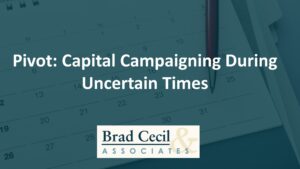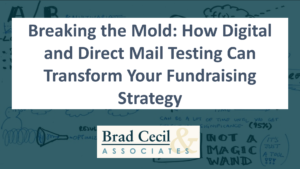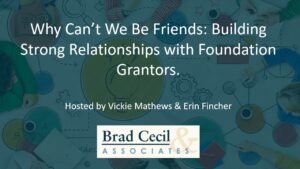Last week, I shared with you the basics of Donor-Advised Funds, a highly debated giving vehicle with more than $120 billion in giving potential. The difficulty many fundraisers experience in accessing information about DAF donors is frustrating, to say the least. Since DAFs are here to stay and growing in number and value every year, learning how to tap into these funds and build meaningful relationships with these donors AND their philanthropic advisors is essential for today’s development teams. So, this week, we’re continuing the conversation with some best practices for identifying and stewarding DAFs.
How to identify the donor
The first step with any donation is to identify the generous donor, and the same is true of DAF gifts. Although the check may come from Fidelity Charitable or your local community foundation, make sure to carefully review additional information that is provided. Quite often, donor information is included in the cover letter or in the paperwork that accompanies the check.
Most DAF administrators report that a minority of DAF donors prefer anonymity. Vanguard Charitable, for instance, reports that only 5% of their donors choose to remain anonymous when making gifts through their DAFs. So, it’s likely that you will receive some kind of insights into the donor who recommended a gift to your organization. Remember to enter that information into your database!
DAF donors do not use this giving vehicle exclusively, so it is entirely possible that the donor is already in your database. Double check to avoid creating duplicate donor records and to ensure that you are creating a comprehensive record of the donor’s support – even if it is through various sources.
There may be an instance of a “Fund” or “Foundation” being listed as the donor associated with a DAF gift. This is where you may need to do a little bit of research to try to identify the individual(s) or family who established the fund. Turn to the philanthropic advisor, the organization’s annual report or even a simple google search to see if you can gain any more insight.
How to communicate with donors
It’s important to not overlook these donors simply because of the way they choose to make their gift. However, there are a few additional considerations as you steward DAF donors and their philanthropic advisors.
Update your Database: When you identify a donor who makes gifts through their DAF, be sure to soft credit their account and flag them as a DAF holder in their constituent record. Often this information is retained only in the gift record. By flagging their constituent record, a simple query can easily identify those who have used a DAF in the past and help you communicate with them in the future.
Communicate with donors directly: Treat DAF donors as you would any other donor and incorporate them into the appropriate communication stream. Even if you do not have their personal mailing address or other direct contact information, send correspondence addressed to them through the organization that administers their DAF. This includes acknowledgement letters (remember, do not include any tax language!), project updates, solicitations, event and tour invitations, newsletters, annual reports, everything! Here are some quick tips for thanking DAF donors from Fidelity Charitable.
Communicate with donors through philanthropic advisors: I recently heard of a practice at The Denver Foundation where they share direct correspondence from nonprofits to their donors in the “Friday Mail”. The donors enjoy the updates and messages from the nonprofits they support and the Foundation staff enjoys participating in the stewardship of that relationship. As I’ve mentioned above, you can still tailor all correspondence directly to the donor and ask their DAF administrator to help share the message.
Treat philanthropic advisors as donors too: One of the best tips that I know to give you when dealing with DAFs is to treat the philanthropic advisors as donors and consider them an asset to your organization. The stronger your relationship with these advisors, the better. And by arming them with the right information about your program or cause, you will gain an advocate among some donors that you may not be able to engage with directly. Steward them just as you would any other donor by thanking them for helping to arrange for a DAF gift to your organization, send them updates, invite them to events, etc.
Make their giving easy
DAF donors already have the intention to support charitable causes by setting up a DAF. Here are a few quick tips to make their giving through their DAF easy:
-
For existing DAF donors, reference their giving through their DAF in acknowledgement and solicitation letters. This shows them that you are paying attention to their giving preferences.
-
For prospective DAF donors, include DAFs in your “ways to give” page on your website, donation forms, email appeals and other donor communications. By reminding people that you accept gifts through this giving vehicle, you are placing your organization at the top of their minds when they consider what to do with their DAF funds.
-
Consider adding the DAF Direct widget to your online donation pages. Keep in mind that this solution does not support all DAF sponsor organizations, but it can make the donation process easier for donors with funds at Fidelity Charitable, Schwab Charitable and the BNY Mellon Charitable Gift Fund.
What’s next?
Now that you have the basics down on DAFs and how to build a relationship with the donors and philanthropic advisors, let’s get into how to practically apply these principles in your organization! Next week, I’ll share some real-world examples of how nonprofits have effectively communicated and deepened relationships with Donor-Advised Fund donors and their philanthropic advisors.
Do you have questions about DAFs that I haven’t covered yet? Send them to me! I’m compiling a list of FAQs and would love to include your comments!





